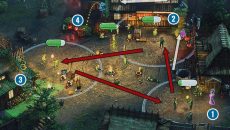“Celeste” was nominated for “Original Light Mix Score, New IP” at the National Academy of Video Game Trade Reviewers Awards. (Photo courtesy of Matt Makes Games)
Brendan Jacques
Connector Staff
“Celeste” is a single-player 2-D platformer created by Matt Makes Games Inc., an indie developer best known for the competitive 2-D brawler “TowerFall.”
Players take on the role of Madeline, a young woman attempting to scale Mount Celeste, a fictional mountain in western Canada, with the hope that doing so will help to heal her self-confidence and allow her to take control over her life after an unspecified tragedy left her coping with depression. However, Mount Celeste is not so easily scaled, as Madeline is soon beset by a shadowy doppelganger of herself created by the mountain’s magic who wants nothing more than for her to give up her journey and turn back.
Overall, the story is fairly good, tackling themes of depression, self-worth and the mindset that encourages people to seek out difficulty for its own sake in a way that, while not without its issues, is both entertaining and uniquely heart-warming.
Gameplay in “Celeste” is simple and straightforward: each level tasks the player with solving a series of platforming puzzles using a combination of jumping, climbing and air dashing in order to get Madeline further up Mount Celeste step-by-step. These puzzles range from traditional “Mario”style faire, such as navigating across moving platforms, to more unique yet simple-to-grasp challenges, such as climbing under intense weather conditions or taking advantage of momentum to make impossible leaps. To the game’s benefit, while every level introduces its own twist on the core formula in order to keep each puzzle feeling fresh, things never get any more complicated than getting from point A to point B.
In this case however, simple does not mean easy. “Celeste” wears its influences from genre contemporaries like “Super Meat Boy” and “N++” on its sleeve, with many of its later levels demanding absolute precision of movement and solid planning on the player’s part in order to be completed effectively. At the same time though, the game never uses its difficulty as an excuse to be cruel to the player.
While stages are often very difficult to complete, fast respawn times, the absence of any penalty for death and precise controls whose physics and movement have been well-polished keep most challenges from feeling unfair. There is never a point where what the player needs to do is unclear; it is always a matter of whether or not they can do what the game requires.
At the same time, the game makes sure to offer a greater challenge to those who feel they can handle it by hiding a level’s toughest challenges down optional side paths, placing collectible “strawberries” in tough-to-reach sections to encourage more difficult solutions to existing puzzles, and through unlockable “B-Side” versions of each level in the game. These design choices amount to a gameplay experience that, while always demanding of the player’s attention, never forgets that the point is to have fun and provides the tools to let the player choose the amount of challenge they are the most comfortable with.
This encouraging design extends to the presentation as well. Environments in “Celeste” are a pixel art masterclass, each level theme feeling more vibrant and imaginative than the one preceding. The soundtrack is also worthy of praise, with a mix that not only works to accentuate the themes of the story and each area perfectly, but also steadily ramps up in complexity in sync with a stage’s own rising difficulty, an effect that makes each stage feel much more energetic. Despite this, the sound and visuals never get overwhelming to the point of distracting from gameplay, with Madeline’s alternating red and blue hair contrasting her well with each successive environment and clever color-coding making sure hazards are always visible regardless of what is happening on-screen.
Lastly, it should also be noted that on top of the quality-of-life design decisions in the game itself, “Celeste” also includes a robust assist mode for those finding the game too difficult to complete, with options available to decrease gameplay speed, grant Madeline infinite air dashes or even to skip levels entirely, all welcome additions that show the developer’s willingness to go the extra mile and make their game as accessible as possible.
All told, “Celeste” is a wonderful platformer that comes highly recommended. While certainly not for everyone, it acts as a sublime introduction into the precision platformer genre whilst offering a story that touches on themes not often covered in gaming. This is one mountain that is absolutely worth the climb.
Final Grade: A-




